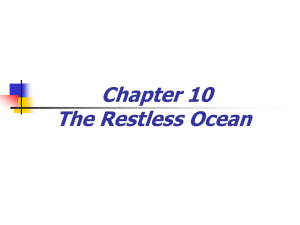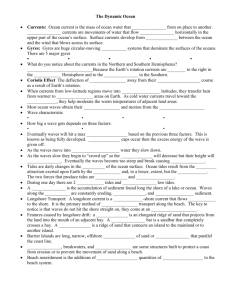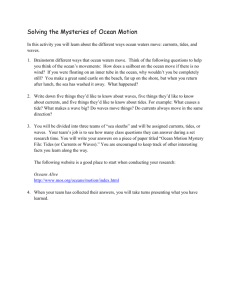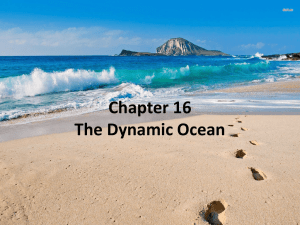Volcanoes and Igneous Activity Earth - Chapter 4
advertisement
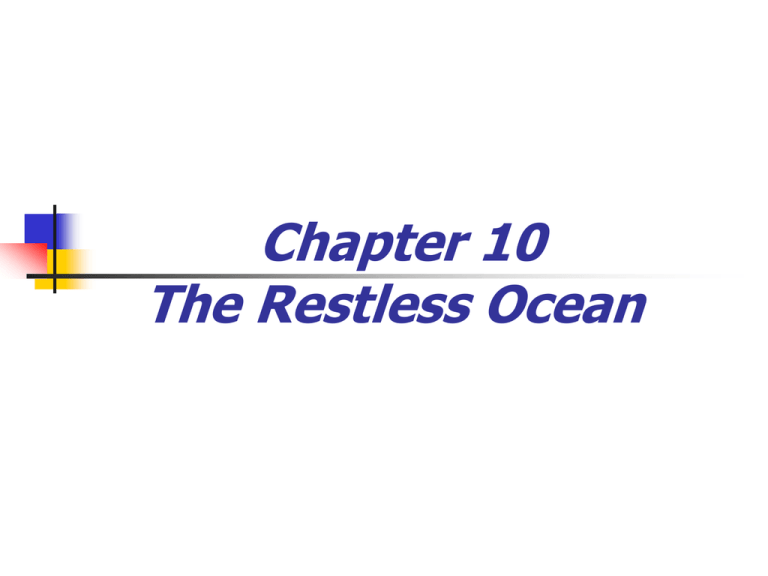
Chapter 10 The Restless Ocean Ocean Water Movements Surface circulation Ocean currents are masses of water that flow from one place to another Surface currents develop from friction between the ocean and the wind that blows across the surface Huge, slowly moving gyres Ocean Water Movements Surface circulation Five main gyres North Pacific gyre South Pacific gyre North Atlantic gyre South Atlantic gyre Indian Ocean gyre Related to atmospheric circulation Average Ocean Surface Currents in February–March Figure 10.2 Ocean Water Movements Surface circulation Deflected by the Coriolis effect To the right in the Northern Hemisphere To the left in the Southern Hemisphere Four main currents generally exist within each gyre Importance of surface currents Climate Currents from low latitudes into higher latitudes (warm currents) transfer heat from warmer to cooler areas Ocean Water Movements Surface circulation Importance of surface currents Climate Influence of cold currents is most pronounced in the tropics or during the summer months in the middle latitudes Upwelling The rising of cold water from deeper layers Most characteristic along west coasts of continents Ocean Water Movements Deep-ocean circulation A response to density differences Factors creating a dense mass of water Temperature—Cold water is dense Salinity—Density increases with increasing salinity Called thermohaline circulation Ocean Water Movements Deep-ocean circulation Most water involved in deep-ocean currents begins in high latitudes at the surface A simplified model of ocean circulation is similar to a conveyor belt that travels from the Atlantic Ocean, through the Indian and Pacific Oceans, and back again Idealized “Conveyor Belt” Model of Ocean Circulation Figure 10.6 Waves Waves Energy traveling along the interface between ocean and atmosphere Derive their energy and motion from wind Parts Crest Trough Waves Waves Characteristics Wave height—The distance between a trough and a crest Wavelength—The horizontal distance between successive crests (or troughs) Wave period—The time interval for one full wave to pass a fixed position Characteristics and Movement of Waves Figure 10.7 Ocean Water Movements Waves Wave height, length, and period depend on Wind speed Length of time the wind blows Fetch—The distance that the wind travels As the wave travels, the water passes energy along by moving in a circle Changes That Occur When a Wave Moves onto Shore Figure 10.9 Beaches and Shoreline Processes Beaches are composed of whatever material is available Some beaches have a significant biological component Material does not stay in one place Wave erosion Caused by Wave impact and pressure Breaks down rock material and supplies sand to beaches Beaches and Shoreline Processes Wave refraction Bending of a waves Wave arrives parallel to shore Results Wave energy is concentrated against the sides and ends of the headland Wave erosion straightens an irregular shoreline Wave Refraction Along an Irregular Coastline Figure 10.12 Beaches and Shoreline Processes Longshore transport Beach drift—Sediment moves in a zigzag pattern along the beach face Longshore current Current in surf zone Flows parallel to the shore Moves substantially more sediment than beach drift Beach Drift and Longshore Currents Figure 10.13 Shoreline Features Erosional features Wave-cut cliff Wave-cut platform Marine terraces Associated with headlands Sea arch Sea stack Erosional Features Figure 13.10 Sea Arch Figure 10.18 Sea Stack Shoreline Features Depositional features Spit —A ridge of sand extending from the land into the mouth of an adjacent bay with an end that often hooks landward Baymouth bar —A sand bar that completely crosses a bay Tombolo—A ridge of sand that connects an island to the mainland Depositional Coastal Features Figure 13.11 Aerial View of a Spit and Baymouth Bar Along the Massachusetts Coastline Figure 10.16 Spit Figure 10.18 Baymouth Bar Tombolo Figure 10.18 Shoreline Features Depositional features Barrier islands Mainly along the Atlantic and Gulf Coastal Plains Parallel the coast Originate in several ways Stabilizing the Shore Shoreline erosion is influenced by the local factors Proximity to sediment-laden rivers Degree of tectonic activity Topography and composition of the land Prevailing wind and weather patterns Configuration of the coastline Stabilizing the Shore Responses to erosion problems Hard stabilization—Building structures Types of structures Groins —Barriers built at a right angle to the beach that are designed to trap sand Breakwaters—Barriers built offshore and parallel to the coast to protect boats from breaking waves Stabilizing the Shore Responses to erosion problems Hard stabilization—Building structures Types of structures Seawalls—Armors the coast against the force of breaking waves Often these structures are not effective Stabilizing the Shore Responses to erosion problems Alternatives to hard stabilization Beach nourishment by adding sand to the beach system Relocating buildings away from beach Erosion problems along U.S. Coasts Shoreline erosion problems are different along the opposite coasts Littoral Drift Figure 13.12 Miami Beach Before Beach Nourishment Figure 10.22 A Miami Beach After Beach Nourishment Figure 10.22 B Stabilizing the Shore Erosion problems along U.S. Coasts Atlantic and Gulf Coasts Development occurs mainly on barrier islands Face open ocean Receive full force of storms Development has taken place more rapidly than our understanding of barrier island dynamics NC Barrier Islands Figure 13.13 Stabilizing the Shore Erosion problems along U.S. Coasts Pacific Coast Characterized by relatively narrow beaches backed by steep cliffs and mountain ranges Major problem is the narrowing of the beaches Sediment for beaches is interrupted by dams and reservoirs Rapid erosion occurs along the beaches Beach Erosion Figure 13.20 Coastal Classification Shoreline classification is difficult Classification based on changes with respect to sea level Emergent coast Caused by Uplift of the land, or A drop in sea level Coastal Classification Classification based on changes with respect to sea level Submergent coast Caused by Land adjacent to sea subsides, or Sea level rises Features of a submergent coast Highly irregular shoreline Estuaries —Drowned river mouths Major Estuaries Along the East Coast of the United States Figure 10.23 Tides Changes in elevation of the ocean surface Caused by the gravitational forces exerted upon the Earth by the Moon, and to a lesser extent by the Sun Idealized Tidal Bulges on Earth Figure 10.25 Tides Monthly tidal cycle Spring tide During new and full moons Gravitational forces added together Especially high and low tides Large daily tidal range Earth-Moon-Sun Positions During the Spring Tide Figure 10.26 A Earth-Moon-Sun Positions During the Neap Tide Figure 10.26 B Tides Monthly tidal cycle Neap tide First and third quarters of the Moon Gravitational forces are offset Daily tidal range is least Tidal patterns Many factors influence the tides Shape of the coastline Configuration of the ocean basin Water depth Tides Tidal patterns Main tidal patterns Diurnal tidal pattern A single high and low tide each tidal day Occurs along the northern shore of the Gulf of Mexico Semidiurnal tidal pattern Two high and two low tides each tidal day Little difference in the high and low water heights Tides Tidal patterns Main tidal patterns Mixed tidal pattern Two high and two low waters each day Large inequality in high water heights, low water heights, or both Prevalent along the Pacific Coast of the United States Tides Tidal currents Horizontal flow accompanying the rise and fall of tides Types of tidal currents Flood current—Advances into the coastal zone Ebb current—Seaward moving water Sometimes tidal deltas are created by tidal currents Features Associated with Tidal Currents Figure 10.28 End of Chapter 10

